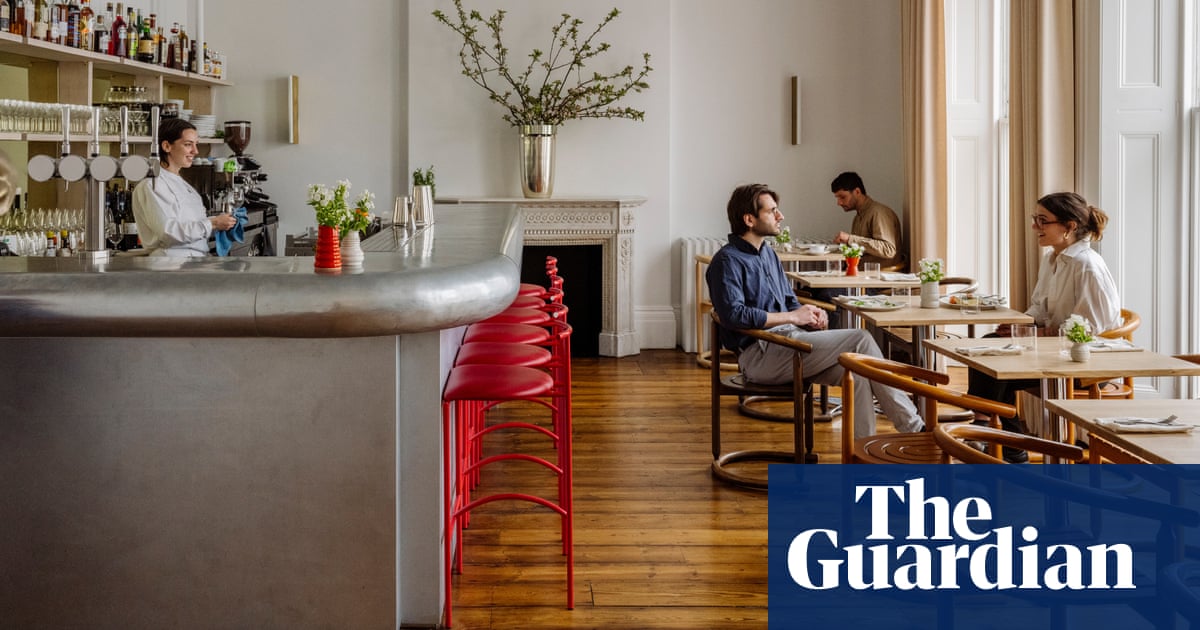One of the main challenges of writing a weekly restaurant column is finding new ways (and at least 11 times a year) to describe the experience of eating Mediterranean small plates in a room painted inLittle Greene’s Silent White. Other food – and, indeed, paint colours – are available, but in recent years, whenever you cast an eye over some hot, hip new place, you need to brace yourself for polenta, coco beans, galettes and neutral furnishing.The Lavery, just opposite the Natural History Museum in South Kensington, is by no small margin the new emperor of this style of cooking and decor, with a formerRiver Cafe,Petersham NurseriesandToklaschef, Yohei Furuhashi, serving up gnocchi with fresh peas on the upper floors of a dreamily restored, Grade II-listed Georgian townhouse.
This room iswhite– let’s call this shadeJohn Lennon Imagine Video White, or Ascending To Heaven And Sitting At The Right Hand Of The Father White. It’s all very heavenly, anyway. There are gilt-edged, floor-to-ceiling mirrors, original fireplaces and expensive wooden flooring. It’s modern minimalist with a glut of leftover grandeur from fine times past, whenthe Irish painter Sir John Laveryand his wife Lady Hazel lived here. The Lavery is not only beautiful, but useful, too, being close enough to the museums to make it a fine place to pop into after a trip to the V&A, or after enduring the half-term scrum aroundHope, the blue whale skeleton, at the Natural History. Would I take children to the Lavery, though? I’m not too sure. What are your kids like? Will they eat blood orange and puntarelle salad with taggiasche olives? Do they say things like, “Mummy, can I have the Isle of Skye scallop with cime de rapa, tomato and cedro, please!” If the answer to either of those questions is no, it’s possibly not the brightest idea.
But the Lavery is very definitely suitable for people who have glanced at the menu and prices at Furuhashi’s former haunt, the River Cafe, and thought: “Ha ha ha! I must get my eyes tested. For a moment there, I thought that read £49 for an antipasto of grilled langoustines and £68 for a sea bass and artichoke main! Oh …” The fact that Furuhashi is now in South Kensington, overseeing this wholesome, rustic, yet semi-decadent modern European cooking for a fraction of those prices is reason enough to skip over to this side of town. Take the monkfish main, a generous portion, with perfectly cooked flesh on white alubia beans with marinda tomatoes and a pleasingly rough-and-ready mojo verde for £36. Absolutely delicious.
We started with a plate of fluffy, pungent salt cod with fried polenta (of course) and Iberiko winter tomatoes of sublime quality. Then there was also some excellent, balm-like, soft and runny burrata with fresh peas, pea shoots, fennel and a scattering ofbottarga, which we ate with ciabatta dipped inTwo Fields Greek olive oil. I can’t lie: before we started to eat, I had felt a bit lukewarm about the Lavery, because, despite its culinary pedigree and sumptuous location, I failed to see how it might be outstanding. But that thinking waswayoff. There is a precise, exemplary method to the cooking, plating and sourcing that elevates it into one of London’s loveliest new places to eat.
The main course choice featured rabbit leg stuffed with Tuscan sausage and Castelluccio lentils, and artichoke ratatouille with chickpea farinata, but we were both swung by Swaledale lamb with jersey royals, courgettes, chilli and mint, and an elegant, multi-leaved “little salad” on the side. Service was polite but formal. An Instagram influencer pest turned up in the middle of our meal, began waving her camera about and was firmly told to sit down twice, which I wholly respect. More of this please: sit down and eat your dinner, lady, we are not your film set.
None of this distracted me from the pudding list, though, which may be coyly diminutive, but make no mistake, theOriginal Beanschocolate mousse with Agen prunes is one of the most delicious things being served on Planet Earth right now. This plump, puckered, glossy quenelle of joy with two fat, boozy prunes makes every other chocolate mousse in the UK taste likeInstant Whip. We also managed a slice of loquat and hazelnut tart with chantilly cream, a sort-of-rustic, buttery frangipane tart that very much hit the spot.
All in all, then, there’s something rather special happening here, even if, on the surface, it may appear to be rather snoozily boring. Apparently, they’re opening a downstairs cafe soon, for more grab-and-go-type fare, though I just can’t see that myself. I doubt the Lavery has anything as casual as a sarnie or a flapjack in its repertoire.
The Lavery4-5 Cromwell Place, London SW7, 020-8057 1801. Open Tues-Sat, lunch noon-2.30pm, dinner 5.30-9pm (last orders). From about £60 a head for three courses, plus drinks and service
